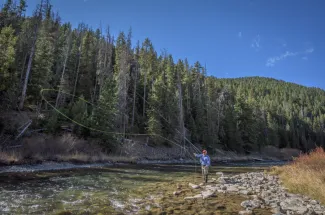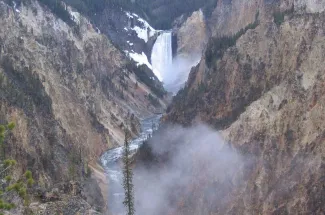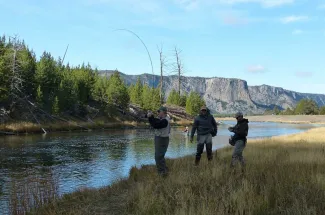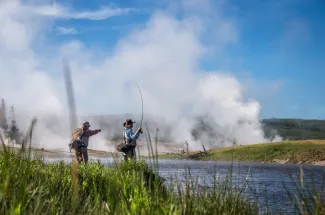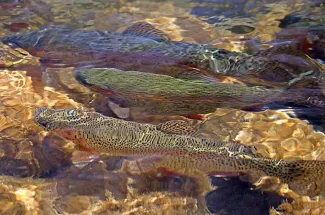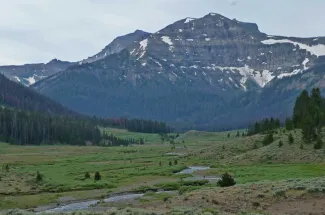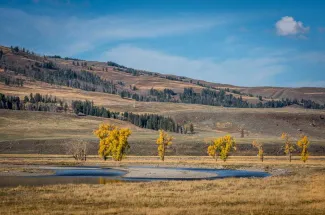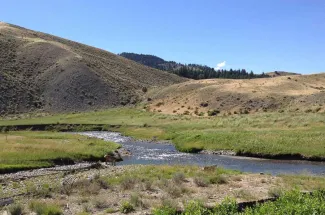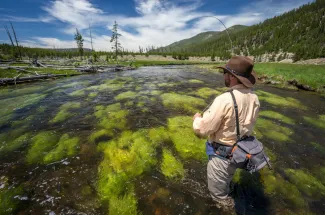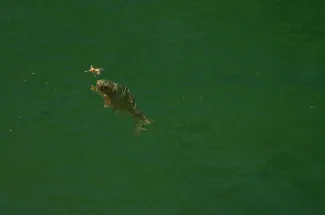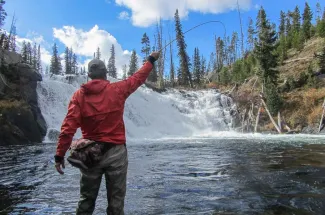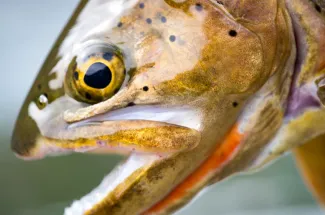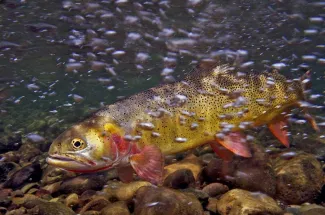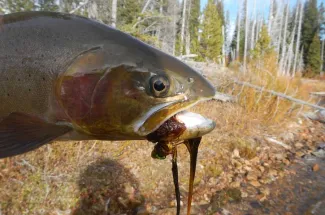Montana Angler is a licensed outfitter offering guided fly-fishing trips in Yellowstone National Park. Fly fishing in Yellowstone combines a wild setting, spectacular scenery and great angling opportunities. Many of the world's most famous trout streams such as the Yellowstone, Gallatin, Madison and Snake are born inside of the park. Fly-fishing trips inside Yellowstone National Park are exclusively walk and wade only by regulation. The fisheries are bountiful and diverse and range from the massive Yellowstone River in the Black Canyon to tiny brook trout streams in remote valleys. The fishing can be as easy as walking a few yards from a pull-off to making an epic hike into the Grand Canyon of the Yellowstone. Yellowstone Park opens to fishing on Memorial Day Weekend and runs into the first week of November.
Fly Fishing Trips in Yellowstone National Park
The Gallatin River starts its journey within Yellowstone National Park in the northwest corner of the park high in the Gallatin Mountain range. Gallatin Lake, a picturesque
The Parks’ namesake river, the Yellowstone traverses the entire park from south to north. The best fishing is located in the Grand and Black Canyon's, which require a hike in access in most cases. Abundant hatches, fantastic dry fly fishing and killer scenery make donning your hiking boots more than worth it.
One of Yellowstone Parks’ largest rivers, the Madison is viewed by millions of visitors each year as it meanders along the West Entrance Road. What you will see here is completely different than in the famous waters waters outside the park in the state of Montana. While the Montana stretch is swift, rocky, and peppered with huge boulders, the Park reach resembles a big spring creek. Aquatic grasses wave in the current and much of the riverbed is sand or small pebbles. Elk and bison are frequently spotted along the grassy banks and the river is home to one of the very few resident pairs of Trumpeter Swans in the entire park.
The Firehole is quite possibly the most unique trout river in the world. It flows through three of the largest and most active geyser basins in the world, including iconic thermal features such as Old Faithful and Grand Prismatic spring. The outflow from these features flow directly into the river and you will have to dodge mud pots and hot springs as you walk along the banks. Wildlife is plentiful in the area, with frequent sightings of elk, bison and bear. The Firehole would be a worthwhile destination without even wetting a line, but fortunately for anglers the river boasts a prolific population of both trout and insects.
Located in the far South-Western portion of Yellowstone Park, the Bechler River is probably the least well known major river in the park. It is located in the small portion of Yellowstone that falls in Idaho, and is not accessible from any interior park road. Instead, one must travel north from the town of Ashton, Idaho to gain access to the Bechler country. The road dead-ends just inside the park boundary, so fishing the Bechler requires a hike. While this region of Yellowstone is known to backpackers and hikers for its abundance of waterfalls and hot springs, it is far off the radar of the average visitor and most fisherman.
Consisting of 4 separate meadows, Slough Creek is among Yellowstone Park's most famous fisheries. Only the lowermost meadow is road accessible, so be prepared to lace up your boots and hit the trail in search of large, native Yellowstone Cutthroat's eating dry flies.
The Lamar is the namesake of one of the most beautiful areas of Yellowstone National Park, the Lamar Valley. Though the river flows for over 40 miles in all, it is this 7 mile stretch that has made the Lamar famous in fly fishing circles. Though Rainbow Trout have encroached over the years, the river remains a stronghold for the native Yellowstone Cutthroats. The Lamar is well know for it's terrestrial dry fly fishing during the summer.
The Gardner is a fairly small river located in the extreme northwestern corner of Yellowstone National Park. It is a prototypical pocket water fishery, with many boulder gardens and few deep, slow pools. The Gardner has excellent nymph fishing early and late in season, with frequent hatches and good dry fly fishing during the summer months.
One of the major sources of the world famous Madison River, the Gibbon is a good fishery in its own right. From small pocketwater to slow, spring creek like glides, the Gibbon offers a tremendous variety of water and fish.
Grebe Lake is an intriguing option for fly fishing in Yellowstone National Park because it contains Arctic Grayling, a unique Salmonid that is rare in the Lower 48. Grebe is fairly large for a mountain lake, at just over 150 acres. Portions of the shoreline are marshy and tough to wade, but much of the lake has a grassy shore with a firm bottom, offering easy wading and casting.
Located in the southern portion of Yellowstone Park, the Lewis is part of the Snake River drainage that flows south towards Grand Teton National Park. Since most fishing in Yellowstone Park is focused on the Madison and Yellowstone drainages in the western and northern sections of the park, respectively, these southern fisheries are often overlooked.
Soda Butte Creek is a tributary of the Lamar River and another of Yellowstone Park's famous Cutthroat Trout fisheries. The stream is a mixture of wide open meadows and tree-lined pocket water. Soda Butte provides excellent dry fly fishing during the summer season.
Located on a tiny tributary of Soda Butte Creek in the far northeastern corner of the park, Trout Lake sits in a small bowl adjacent to a beautiful alpine meadow. In the early 1900’s, the National Park Service ran a fish hatchery in Trout Lake, a testament to the lakes’ fertility. The fish in Trout Lake are impressive, with Cutthroats ranging from 14-22” and the Rainbows, while scarce, can run 20-30”.
Yellowstone Lake is an impressive body of water and a national treasure. Unfortunately, this famous Cutthroat fishery has been decimated by the illegal introduction of Lake Trout. The National Park Service is working hard to remove Lake Trout and fishing is slowly improving.


